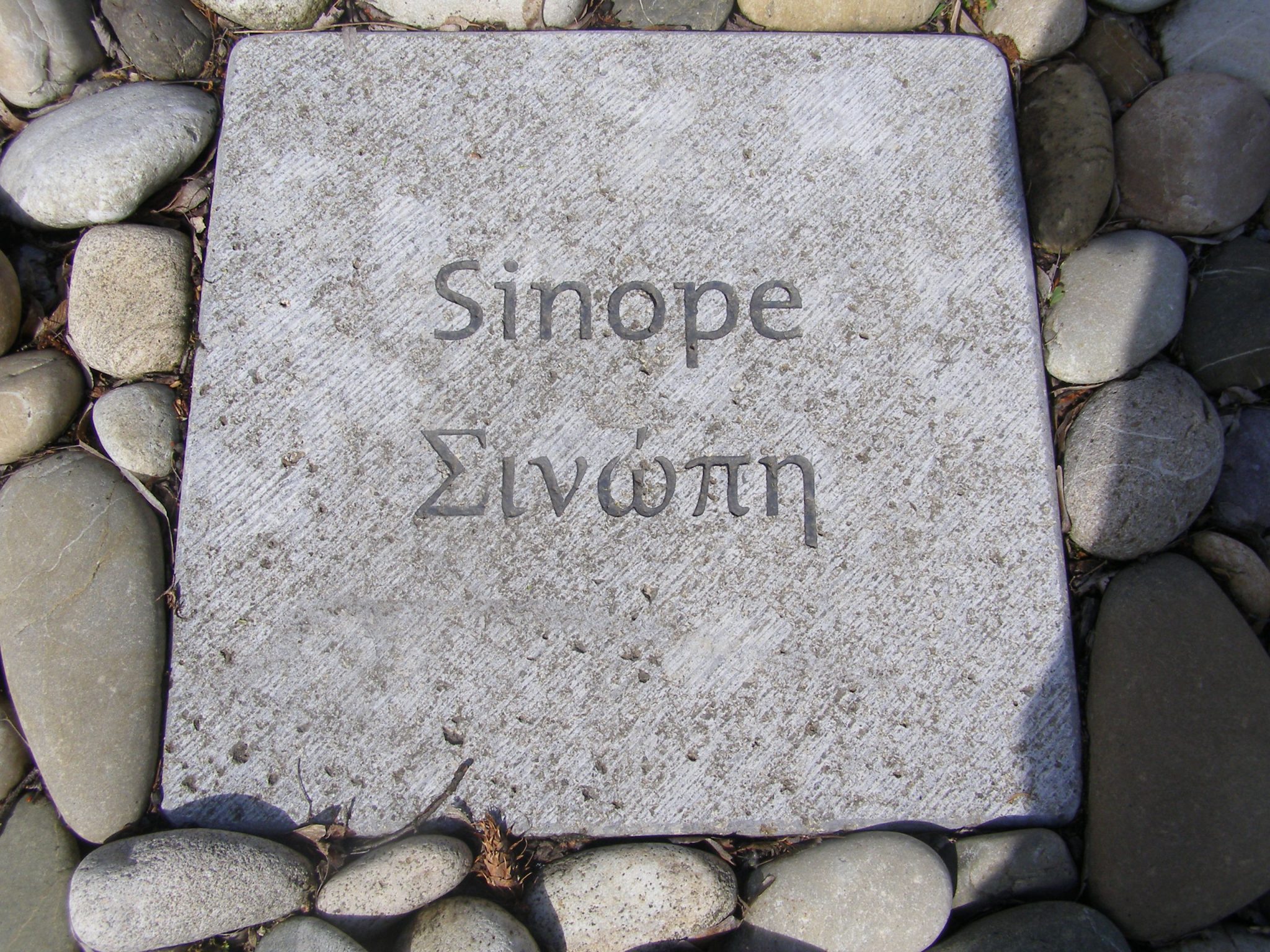
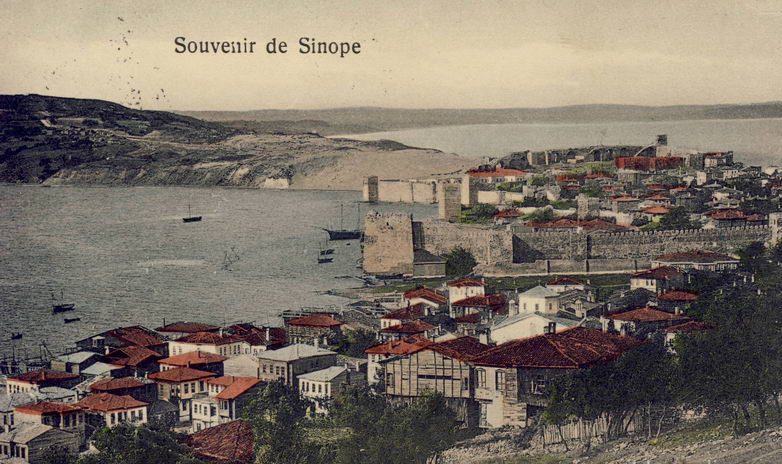
Population
According to the 1881/1882-1893 general Ottoman census, the total population of the kaza of Sinop was 44,656. Of these, 40,254 were Muslim, 4,063 were Greeks, 273 were Armenians and 66 were non-Muslim gypsies.[1]
City of Sinope / Σινώπη
Sinop (Σινώπη, Sinopolli, Sinub) on the southern coast of the Black Sea lies on an isthmus linking the Boztepe Peninsula to the mainland and is shut off from the Anatolian Plateau to the south by high, forest-clad mountains.
Because it has the only safe natural roadstead on the north coast of Asia Minor (Anatolia), Sinope was in antiquity the foremost port on the coast, with its land approaches barred by a huge citadel (now in ruins) and its sea side defended by a strong wall. Its decline was associated with its lack of easy access to the interior and its rivalry with İnebolu on the west and with Samsun on the east.
Sinope, the ancient city of Pontus was founded by the Miletians in the 7th century B.C. According to mythology its founder was the Argonaut Autolycos. The region was well known by Phoenician seafarers who traded with the pre-Hellenic people. Apart from the Miletians, the Cimmerians have also been mentioned as settling in Sinope after fleeing from the Scythians.
According to ancient writers, the Miletians founded Sinope after an agreement with the town’s native people.
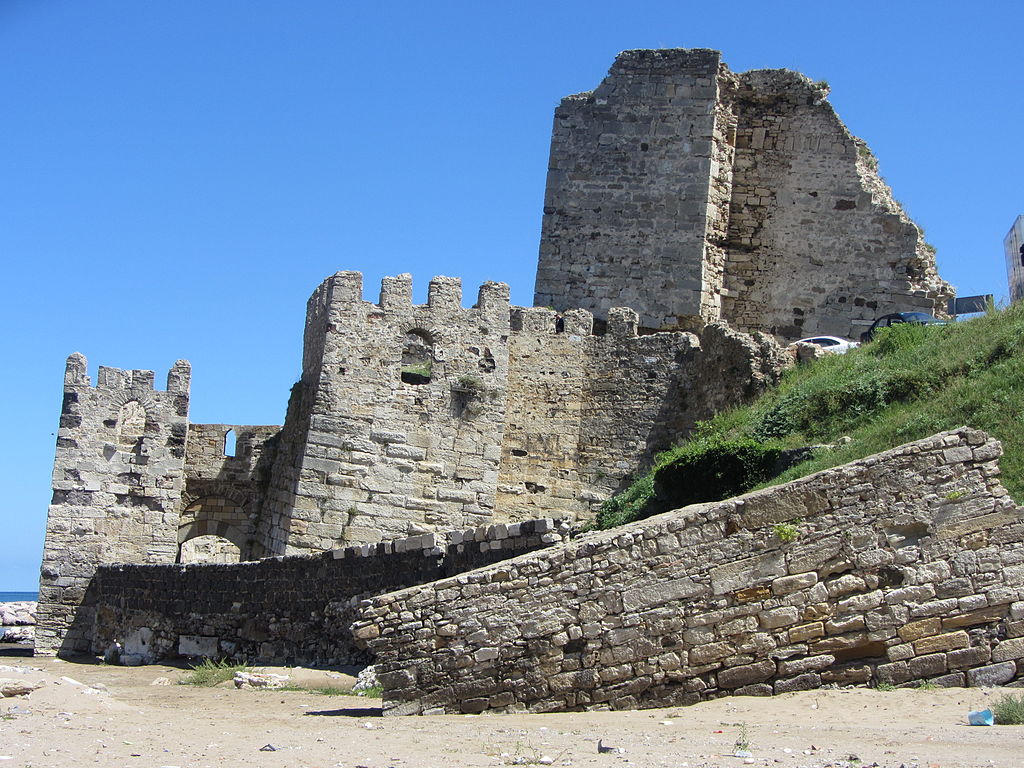
History
Sinope was the first Greek colony of Pontus. Soon after being colonized, Sinope’s population increased dramatically. The ‘barbaric’ people either moved out of the region or assimilated. According to Herodotus and Xenophon, Sinope increased so drastically in wealth that it founded other colonies such as Trapezunta (Trebizond), Kotyora (Ordu) and Kerasunta (Kerasus) [Giresun]. Xenophon mentions that according to the customs during that period the people of Kotyora, Kerasunta and Trapezunta all paid a tax to the Metropolis who then sent governors to their towns. According to Xenophon, these governors complained many times to the Myrian leaders about better representing Sinope. It is unknown whether this dependence existed after the late 7th century B.C.
During this same period (end of the 7th century B.C.) Sinope was a member of the Athenian alliance. Pericles and Lamachos visited Sinope and helped to overthrow the tyrant Timiseleos.
In 375 B.C., a Persian named Datames, the satrap of Cappadocia launched an attack on Sinope and managed to seize it for a brief period, however his actions turned out to be in vain. In 368 B.C. he returned and this time he managed to make a complete seizure of the town. Despite this, he respected the prior administration of the town and as a result included Sinope in the Persian state (in name only). During the years of Alexander the Great, Sinope constituted a part of his empire and in time it was passed on, at least in name, to his successors.
In 220 B.C., Sinope was seized by Mithradates [Mithridates] IV, King of Pontus, despite the help of the Rhodesians (Ρόδιοι) who were allied to Sinope. In 183 BC, Sinope was taken over by Pharnaces I, the successor of Mithridates IV, who made it the capital of his state. Pharnaces I and later his successors, all contributed to building amazing buildings and temples. Mithradates [Mithridates] VI Eupator (“good father”) who grew up and was later buried at Sinope, showed extreme interest in beautifying the town during his years as king. According to Strabo, Sinope was beautifully decorated with temples, stoas and groves however they encountered various catastrophes during the Mithridatic Wars.
The town was seized in 70 B.C. by the Roman Lucullus; however it again regained its independence and so didn’t merge with the Roman Empire. In 47 BC it found itself under the rule of Pharnaces II however not for long; the Romans forcing him to flee. It became a Roman colony in 44 B.C. Many Roman legions moved there and began subdividing and sharing the land with the Sinopites. During the Roman period Sinope initially constituted a part of Bithynia but later became a part of Galatian Pontus.
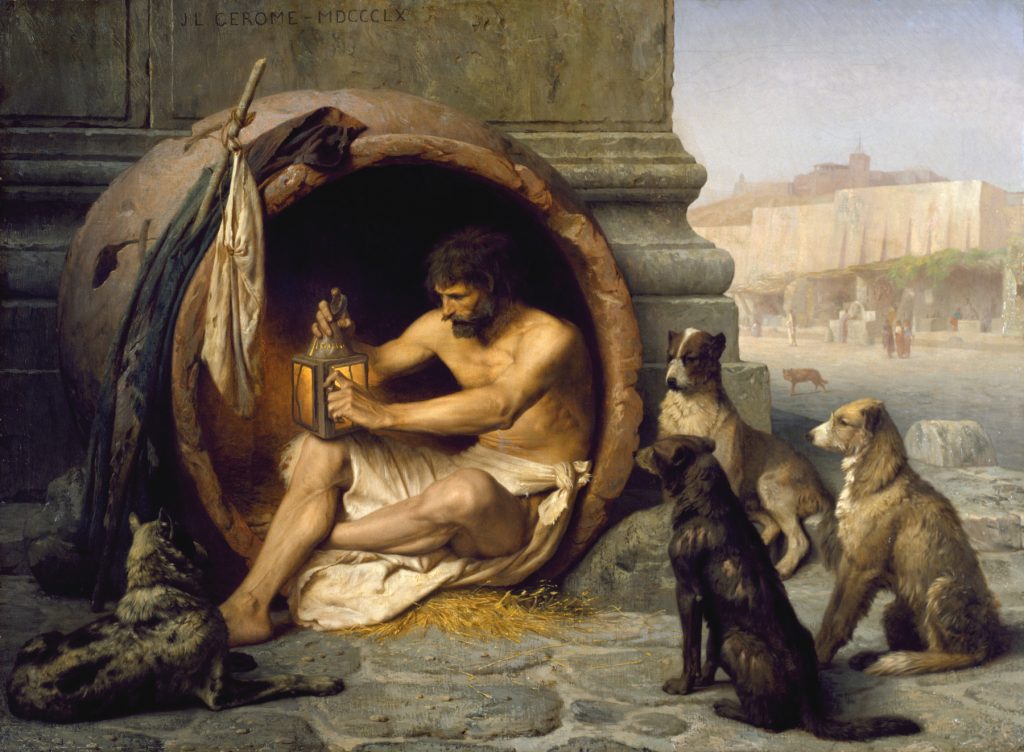
In ancient times, Sinope was the birthplace of the cynic philosopher, Diogenes, of Diphilos, the comic poet, and Aquila, the Jew, who translated the Old Testament into Greek in the second century A.D.
During the Byzantine years, Sinope decreased in importance, however it became a part of the Armeniac Theme (Αρμενιακών). It remained under Byzantine administration until the middle of the 11th century at which time it was seized by the Turkish emir Hartik. However, it was regained in a short period of time by Alexios Comnenos. After the sacking of Constantinople by the crusaders of the 4th crusade it became a part of the kingdom of the Comnenian rulers until it fell to the Seljuks of Iconium in 1214. During this seizure of Sinope, David Comnenos, the brother of the first Emperor of Trebizond Alexios I was killed. Later, Sinope was to become a semi-independent Turkoman emirate governed by the Sfentiar family (Ισφεντιαρογλου; Candarids). In 1462, the last Emir of Sinope, Ismail, handed it over to the Ottoman sultan Mohamed [Mehmet] II who forced many of the Greek residents to flee (to Constantinople) so that he could populate Sinope with his own people.
In November, 1853, the Ottoman fleet was destroyed by the Russians in the port of Sinope.
The church of Sinope
A Christian community existed in Sinope in the first half of the second
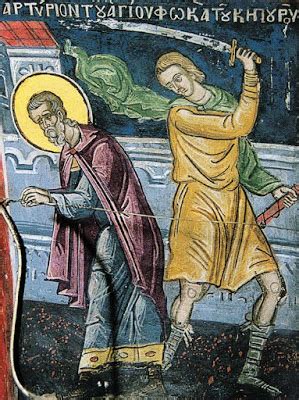
century, with a bishop, the father of the celebrated heretic Marcion, whom he expelled from his diocese.
According to many sources Christianity in the region was declared by Apostle Andrew. The first bishop of Sinope was the gardener Phokas, venerated on 22 September. The cult of Saint Phokas became the most popular in the Euxine.
Immediately after the distribution of Christianity in Pontus, Sinope became home to its own Episcope. Later the town became a part of the Metropolis of Hellenopontus, at the same time preserving its own Episcope. In the last 19th and 20th centuries, Sinope was part of the Metropolis of Amaseia.
Population
Under Ottoman rule, i.e. since 1481, the Greek population of Sinope had to live in the city’s unwalled and undefended outskirts. Of the 27 neighborhoods that existed in the first half of the 18th century, seven were Non-Muslim. In the 19th century, Greeks had the second most populous congregation in Sinop following Muslims.
“The most common occupations among the Greek population were related to handicraft and trade: tailor, sherbet seller, aba maker, tinsmith, clockmaker, jeweler, second-hand clothes dealer, carpenter, stonemason, glassmaker, fishmonger, boatman, keeper of a coffee house. In addition, there were non-Muslim laborers, servants, port workers and clergymen. Non-Muslims in the city almost never dealt with agricultural occupations since they did not own land in general. After the second half of the 19th century, Greeks in Sinop began to appear in public institutions such as municipality, administrative council, inferior court, public works commission, council of education, agricultural bank, hospital, school, public debt administration and stage management. For example, there were the names of 39 Greeks working in various public institutions of Sinop in the 1899 Kastamonu yearbook.”[2]
D. Oikonomidis (Ikonomidis) writes, that in 1869, the population of Sinope numbered 15,000, of which 3,000 were Greek Orthodox who belonged to the Diocese of Amaseia. According to Ottoman archives, there were two Greek schools in Sinop in the 1890s, one for boys and the other one for girls,with an average of 2 or 3 teachers worked in them.[3]
Of the surrounding villages, six were inhabited by Greeks, the total of Greeks equating to approximately 4,500 of the 15,000 in total. The Greek schools were sufficiently run by the Greek community and included a Greek community civic school, comprising 8 classes and 6 teachers and 400 students in total as well as a single grade kindergarten.
According to other sources, prior to 1914, Sinope was inhabited by 9,000 Muslims and 5,000 Greeks. The number of Greeks living in the surrounding villages was 5,000. A Catholic encyclopedia numbers the total population of the city of Sinope as 15,000, “about one half of whom are Greek schismatics.”[4]
Many of these Greeks became victims of genocide. Those who survived were resettled in Greece as part of the forcible Exchange of Populations between Greece and Turkey.
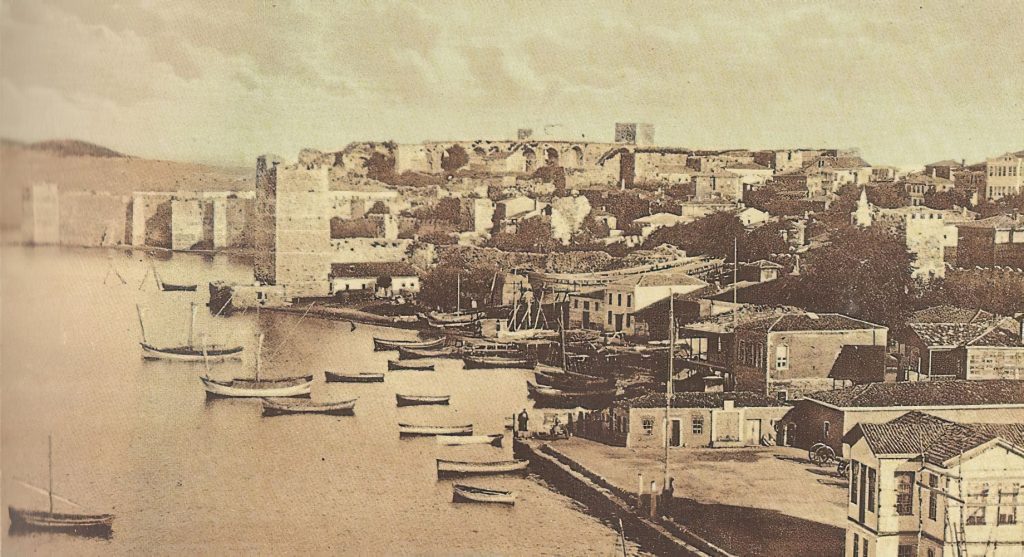
Notable Sinopites
- Diogenes of Sinope, or Diogenes the Cynic (Διογένης ὁ Κυνικός, Diogénēs ho Kynikós); born c. 412 B.C. in Sinope, died 10 or 11 July 323 B.C. in Corinth. He became involved in a scandal involving the adulteration or debasement of the currency; he was subsequently exiled from the Sinope and lost his citizenship and all his material possessions; philosopher and one of the founders of the ancient Greek school of thought of cynicism (κυνισμός).
- Diphilus (4th century B.C)., comedy playwright;
- Mithridates (Mithradates) VI Eupator (the Great): of Greek-Persian origin; born 135/1 B.C. in
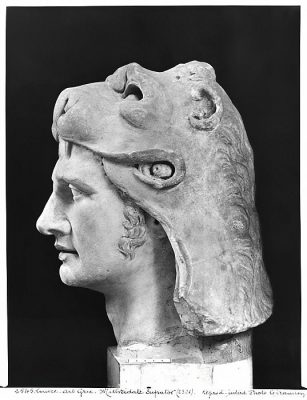
Profile of marble bust oft the Pontic Greek King Mithridates VI Eupator (https://upload.wikimedia.org/wikipedia/commons/b/bc/PonticKingdom.png) Sinope, died 63 B.C. in Sinope or Amaseia; ruled the Pontos Kingdom 120-63 B.C.; pharmacologist;
- Hieromartyr Phokas (Φωκᾶς), died 117 A.D.in Sinope; first bishop of Sinope and wonderworker, especially against fire and drowning; feast day: 22 September;
- Saint Phokas the Gardener, died 303 A.D. (?); martyr. His life and legend may have been a fusion of three men with the same name: Phocas of Antioch, Phocas the Gardener and Phocas, Bishop of Sinope
- Saint Helen Bekiary (died early 18th century; for more information see below)
- Maximus V (Μάξιμος Εʹ; born Vaportzis on 26 October 1897, in Sinope, – 1 January 1972, in Switzerland); Greek Orthodox bishop and Ecumenical Patriarch of Constantinople (1946 until 1948)
Monuments
Lost monuments of Sinope as mentioned by Strabo include the agora, stoa and gymnasium and a number of churches. By the end of the 19th century there were 15 Orthodox churches in the kaza (of Sinope). Most of them appear to have been lost. Some of its pre-Turkish surviving monuments include the street plan, its walls, the palace (Balat) and its church (Balat Kilise).[2]
Destruction
About the extermination of the Armenian and Greek Orthodox Christians in the kaza of Sinop see under sancak of Sinop!
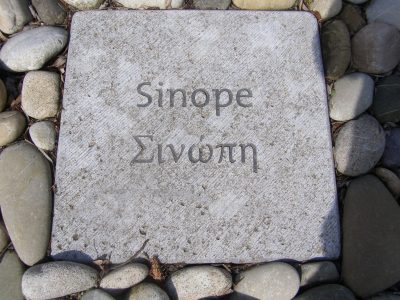
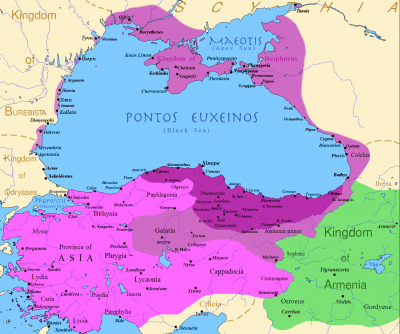
Helen Bekiary, A Virgin-Martyr of Christ
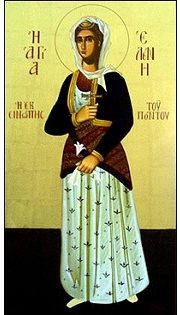
“According to the Orthodox Resources website, Helen was a Greek Christian fifteen-year old living with her family in the Christian enclave at Sinope in Pontus during the 1700s.
After seeing Helen on the street, Ukuzoglu Pasha, the Turkish governor of Sinope ordered her to be kidnapped and brought to his residence. Ukuzoglu then attempted to rape her on two separate occasions, but was stopped each time by what was described as a mysterious power like an invisible wall. Helen later escaped and returned home.
Ukuzoglu then threatened the Christian community with death unless Helen returned to him. The Christian leaders persuaded Helen’s father to return her to the Ukuzoglu, who unsuccessfully tried to rape her several more time. Throughout this ordeal, Helen recited the Six Psalms and other prayers. Ukuzoglu finally sent Helen to prison, where she was tortured. She died from two nails driven into skull and by beheading. After her death, the jailers put Helen’s body in a sack and threw it into the Black Sea. However, the sack floated away with what the Turks described as a heavenly light shining on it.
According to Orthodox Resources, a light coming from the bottom of the sea alerted a crew of Greek sailors to Helen’s resting place. Expecting to find gold, the sailors dove down to the source of the light and found the sack. After they retrieved her remains, a divine revelation showed them to be a source of healing. Helen’s body was sent to Russia, but her head was returned to Sinope, where it was venerated in the Church of the Panagia. This relic was said to be a source of miracles, especially for those suffering from headaches. The local priest would bring the relic to the sufferer, chant a canon of supplication, and sprinkle the person with holy water. When the Turkish army drove the ethnic Greek population from Sinope in 1924, the refugees brought the relic with them to Greece. It is venerated today in the Church of St. Marina in the Ano Toumbas quarter of Thessalonika.”[5]
Helen of Sinope is commemorated on 1 November.
Further Reading:
https://pontosworld.com/index.php/history/christianity/114-the-holy-virgin-martyr-helen-of-sinope